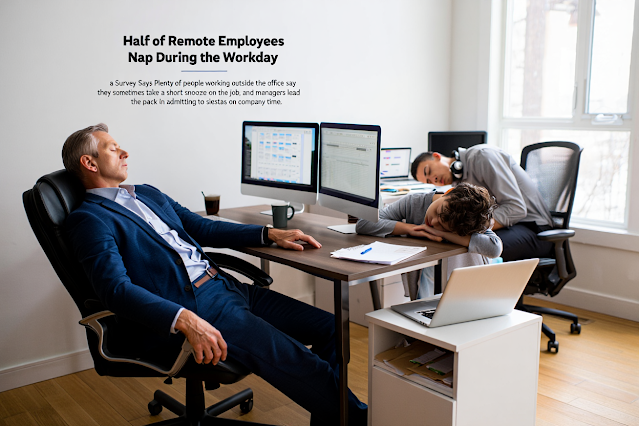As remote work continues to reshape the modern workplace, employers may want to keep a watchful eye—not just for productivity metrics, but also for subtle signs like wrinkled faces, flattened hairlines, or unusually drowsy comments during video calls. It turns out that nearly half of remote workers admit to catching some shut-eye on company time.
The midday slump is nothing new—humans have been battling post-lunch fatigue for centuries. But with the rise of remote and hybrid work models since the pandemic, employees now have more opportunity than ever to give in to those urges without the prying eyes of coworkers or supervisors. According to a survey by U.S.-based mattress company Amerisleep, which polled 1,002 remote and hybrid workers, **48% admitted to taking naps during their workday**.
Before managers start drafting strict anti-nap policies, however, there’s more to consider. Among those who nap during work hours, **53% are actually managers themselves**, compared to 48% of non-managerial employees. This suggests that even those in leadership roles are not immune to the call of the couch.
The Time—and Productivity-Cost—Cost of Workplace Naps
Why should employers care? Because time spent napping can add up quickly. On average, remote workers reported spending about **1.3 hours per week** on daytime naps. Over a year, that adds up to the equivalent of **nine full 9-to-5 workdays** lost to sleep. And this number could rise as younger generations—who seem more inclined toward midday rest—continue to enter the workforce.
A breakdown by generation reveals:
- **Gen Z**: 60% nap on the clock
- **Millennials**: 51%
- **Gen X**: 39%
Additionally, certain professions appear more prone to daytime dozing. Marketing and finance professionals led the pack at **59% each**, followed closely by hospitality/food (54%), education (53%), and retail/e-commerce (51%).
A Surprising Amount of Acceptance
Despite the potential hit to productivity, many employers aren’t exactly sounding the alarm. In fact, **36% of executives said their companies either encourage or tolerate napping during work hours**, provided employees still meet their responsibilities. Even among companies without formal nap policies, **73% of managers support the practice—as long as deadlines are met**.
This shift reflects a broader cultural evolution in how we view rest and performance. Once considered unprofessional or lazy, napping is increasingly seen as a tool for managing energy and stress, especially in flexible remote environments.
The Deception Factor
Still, there’s a complicating factor: **58% of employees who nap during work hide it from their bosses**. Tactics include scheduling fake meetings, using “do not disturb” statuses, or otherwise masking their downtime. When these ruses are uncovered—as they were for 10% of respondents—employers often react more strongly to the deception than the act of sleeping itself. This kind of dishonesty can erode trust and create resentment between teams and management.
Nap-Takers Report Lower Focus and Motivation
Interestingly, despite the perceived benefits of a quick rest, employees who nap during the day reported feeling **less effective, less focused, less motivated, and even less energized** than their non-napping peers. About **25% said they struggle to get back into work mode** after waking up.
This raises questions about whether the short-term relief of a nap might come with longer-term costs in terms of concentration and output.
The Loyalty Trade-Off
On the flip side, offering flexibility around napping could be a way to boost employee loyalty. **55% of workers said they would feel more loyal to an employer that allowed daytime napping**. Some even expressed willingness to trade other perks—like paid time off, office snacks, or social events—for the freedom to take a nap when needed.
The Bottom Line for Employers
For organizations weighing whether to allow or discourage napping, the key consideration is clear: **productivity and accountability**. If employees can maintain performance while occasionally recharging with a nap, many employers seem willing to look the other way—even if it means tolerating a few sleepy Zoom appearances or slightly tousled hairdos.
But transparency matters. Encouraging open communication around breaks and rest could help reduce the culture of secrecy and build trust. For employers considering formalizing nap-friendly policies, the challenge will be balancing compassion for human needs with expectations of output and professionalism.
In the end, the modern workplace may need to make room for more than just efficiency—it might also need to embrace the occasional yawn.

